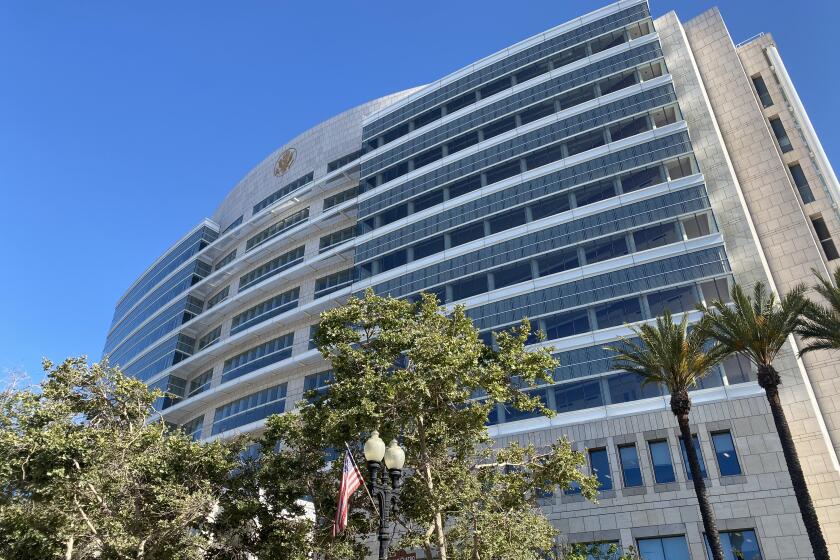AAPI student researchers talk about what it was like to photograph the COVID-19 impact on local communities
- Share via
Last spring, a group of UC Irvine staff and students who work across departments in Asian American studies, public health and the university library’s Southeast Asian archive began discussing a project that would help document the impact of COVID-19 on Asian American and Pacific Islander communities.
They settled on a project based on photography or a photovoice research technique in which participants use a camera to document and express experiences from their own point of view. The intention of the technique is to foster community empowerment and social change in an ethical way that minimizes the power dynamics between the researcher and the researched.
“We found it to be a really compelling methodology. A lot of research approaches tend to rely on words and texts,” said Judy Tzu-Chun Wu, a project lead and director of the UCI Humanities Center. “This really foregrounds the visual and allowed us to sort of step in the shoes of people who are experiencing the pandemic. There’s also more of the emotional impact of thinking about photographs. It’s foregrounding the voices of people who are experiencing the pandemic because we want to hear their stories.”
By the fall, a diverse group of 24 UC Irvine undergraduates were selected to be part of a research project called Visualizing Our Identities and Cultures for Empowerment or VOICE. The project focused on Orange County, which is made up of the third largest AAPI population in the country. However, the students were well into distance learning and spread out throughout California — O.C., Fresno, Ontario, Oxnard and Sacramento.
Part of the strategy to connect student researchers to the local AAPI community was teaming up with staff from six nonprofit organizations: the Cambodian Family, Korean Community Services Health Center, the Orange County Asian and Pacific Islander Community Alliance, the Pacific Islander Health Partnership, the South Asian Network and the Vietnamese American Cancer Foundation.
The students held virtual focus groups to discuss their photos, archived materials and made their project public.
“For our students, it’s been a very difficult time with the pandemic,” said Wu. “There’s issues about mental health, economic insecurity ... they’re trying to do homework as they may be helping to care for their families. There’s a lot of stress on their lives. Being able to capture and share some of those experiences was something that was very empowering for them.”
The result was intimate views of a hanbok shop owner at work, health-related restrictions of dorm life, a grandmother passing down her homemade samosa recipe, tools an asthmatic essential worker needs to leave the house, empty Sikh temples and a cat resting his head on a laptop.
The public showcase for their work was set for a day after the Atlanta shooting, but they decided to postpone their kickoff event and hold space for a conversation to process the shooting instead.
Later in the spring, they held a virtual exhibit titled “Through Our Eyes, Hear Our Stories,” launched a website showcasing the photos and created an Instagram account (which is still actively posting photos).
A subcommittee of students, who received funding from the university’s Undergraduate Research Opportunities Program, held one of the first workshops earlier this week for Anaheim middle and high school students teaching a curriculum plan on how to use the photo voice technique and identify social issues they want to address.
Sorina Neang Long, who focused on co-creating the teaching curriculum, said, “We talked about participatory action and civic engagement. They were really into it, which was exciting. At their age, I was confused about everything. I feel like I’ve just recently discovered methods like photovoice that people can use in their communities to share their stories.”
Now, the VOICE researchers have a proposal in the works to get funding to continue the project. They are interested in capturing California reopening and examining what love looks like in a time of hate.
TimesOC checked in with five VOICE student researchers to talk about the most memorable photos they took in 2020.
Annie My Phan, Vietnamese American, Public Health Science major
Phan currently lives in Little Saigon. When she heard about the project, she knew she wanted to do research related to her community. She decided to take on mental health as a subject, bringing in her experiences as a student and a high school tutor. Phan took a photo of her work desk area located in her bedroom. Throughout COVID-19, the area changed from a comfortable space to a source of stress and anxiety.
“In the AAPI community mental health is not really something that’s addressed,” said Phan. “In high school for my students, it’s a very competitive environment because we’re trying to get to the best colleges and become well known in our career fields. It was very hard adjusting to distance learning when in the previous two quarters I was able to experience some freedom at UCI and meet new people. But when you’re constantly sitting in your room, staring at a Zoom screen, taking notes and not having that working-life balance that you used to have, it was a very difficult process. I could see it in my students because they were burnt out and they couldn’t find the motivation to complete any of their assignments. One of the mentors from the Cambodian Family and I wanted to highlight mental health. Lately, [the nonprofit] realized how important mental health is for people in all age ranges so they’ve held mental health activities, especially for seniors.”
Leyna Ashley Tran, Vietnamese American, Public Health Sciences major
Tran was born and raised in Orange County while her parents immigrated to California from Vietnam in the 1980s. For her, the VOICE project was a chance to broadcast an important topic that resonated with her. In February 2020, her now 93-year-old grandmother needed hospice care. Tran’s family was able to provide the care from their home. Her work focused on her grandmother’s hospital bed in the middle of the living room.
“I think the most impactful picture that I haven’t taken was of my grandmother’s hospital bed,” said Tran. “Throughout the entire pandemic, I hadn’t realized how much it impacted me. I realized after our [focus group] presentation, there are also other students, community health partners and project leads that had also felt the same impact of helplessness and sadness about those in our family who won’t be with us for long. We had taken the time throughout the pandemic to really feel closer with our families and to create stronger bonds, which I was really grateful for … At the time when I took that photo, I was having negative feelings and thinking negative thoughts. I was remembering the time that she was in the hospital and she was practically unresponsive to us when we talked to her. I wanted to reflect on that feeling [in the black-and-white photo].”
Jessica-Gabriela Ramirez, Filipino and Mexican American, Public Health Policy major
In the middle of a rise in anti-Asian sentiment and COVID-19, Ramirez wanted to get involved in the project that addressed the social and political turmoil she was witnessing. But she was hesitant at first. She didn’t know where she fit within the AAPI community since she is both Asian American and Mexican American. She said the VOICE project gave her a chance to speak her truth. One of her significant photos captured what it was like attending a funeral service for her grandfather.
“I had taken a photo of my dad and it was just our hands,” said Ramirez. “His hands are calloused and more aged compared to mine. It was a contrast of generation. Some of the student researchers pointed this out to me, and I had not realized this myself, but the green tent is a very large symbol for funerals. In this moment, we were mourning a death due to COVID-19. The person who had passed away was my lolo [grandfather]. He lived in the United States and sponsored my dad to come over from the Philippines. I was watching my dad capture these last moments at the funeral procession. I didn’t take the picture intentionally. He was having issues trying to figure out his smartphone because he’s not very tech savvy. I was still [video] recording, and I accidentally recorded my hand helping his.”
Sidra Ali, Pakistani American, Public Health Sciences major
Ali’s main sense of community is through her mosque. Before COVID-19, she usually went to the Islamic Center of Yorba Linda on weekends and during Ramadan to break fast. Although her mosque is open this year with social distancing practices in place, Ali didn’t feel comfortable going. In her work, she captured one of the few activities she was able to do at home.
“One year ago, I took a picture of my hand with henna on it,” said Ali. “That picture was really important to me because it was one tradition we still have that I was able to do during COVID. We couldn’t go to the mosque and we couldn’t pray with our community. But we were still able to have henna, which is traditionally female. I was still able to get dressed up and do that with my two younger sisters and my mom.”
Cynthia Fok, Chinese American, Public Health Sciences major
Fok moved back to her Sacramento hometown during COVID-19. Although she wasn’t able to engage with O.C. communities in person, she’s done so through Zoom. Some of her work is centered on Sacramento. At one point, she traveled to San Francisco, where she took a photo of a mural in a nearly empty alleyway that used to be busy pre-pandemic.
“One picture that I took fell under the theme of resilience,” said Fok. “It was a picture of a mural in [San Francisco’s] Chinatown. It wasn’t necessarily painted in response to COVID-19. I’m sure it’s been there for a few years now. It had [representations of ] the Tape vs. Hurley case, which was a Supreme Court case stating that it was unlawful to discriminate against Chinese Americans in the education system. There was another sign that said housing for all. COVID-19 is being called ‘China virus,’ and it’s molding the xenophobic nature of our country. Many people were attacked on the street solely on their race. I thought this mural was a good reminder of the resilience in the Chinese American community and our ability to fight back, regardless of the oppression that we faced.”
All the latest on Orange County from Orange County.
Get our free TimesOC newsletter.
You may occasionally receive promotional content from the Daily Pilot.




